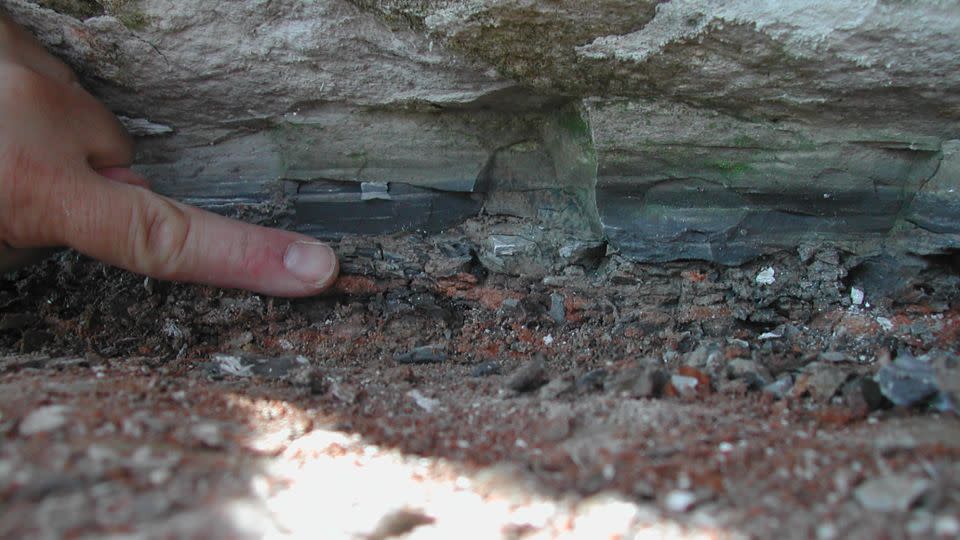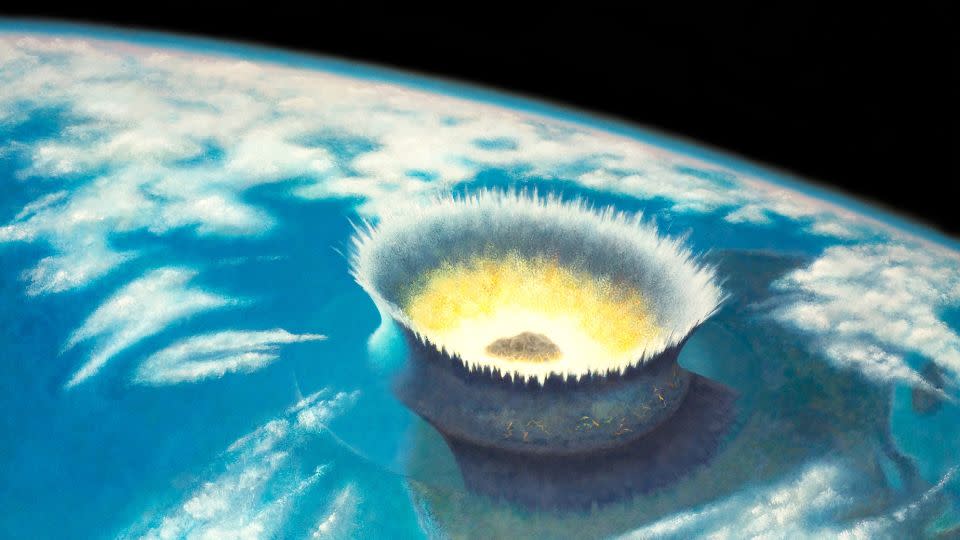Sign up for CNN’s Wonder Theory science newsletter. Explore the universe with news about fascinating discoveries, scientific advances and more.
Sixty-six million years ago, the story of life on Earth took a dramatic turn when an asteroid struck the Yucatán Peninsula in Chicxulub, Mexico. The aftereffects of the impact resulted in the extinction of an estimated 75% of animal species, including most dinosaurs except birds. But almost nothing remained of the asteroid itself.
In a new study published Thursday in the journal Science, researchers have pieced together the chemical identity of the asteroid that fueled the planet’s fifth mass extinction event. The findings suggest the dinosaur killer was a rare ball of clay-rich mud containing materials from the dawn of the solar system.
Although the Chicxulub asteroid touched down on Earth tens of millions of years ago, learning about this ancient space rock is important because it is “part of a bigger picture towards understanding the dynamic nature of our Solar System,” says Dr. Steven Goderis, co-author of the study and research professor of chemistry at the Vrije University of Brussels.
Proposing a theory for the extinction of non-avian dinosaurs
In 1980, scientists suggested that a collision with a giant space rock led to the demise of the dinosaurs. At the time, researchers didn’t find the asteroid itself; instead, they found a thin layer of the metal iridium in rocks around the world from 66 million years ago. Iridium is rare in the Earth’s crust but abundant in some asteroids and meteorites.
Some members of the broader scientific community were skeptical of this hypothesis. But in 1991, scientists found that the Chicxulub crater was the right age to have been formed by a large asteroid impact that coincided with the extinction of the dinosaurs. Over the years, researchers have accumulated more and more evidence that the asteroid impact was indeed the driver of the cataclysmic extinction event.
The asteroid was huge — probably 6 to 9 miles (9.7 to 14.5 kilometers) across. But its sheer size largely accounted for its disappearance. The rock, roughly the size of Mount Everest, hurtled toward Earth at 15.5 miles per second (25 kilometers per second), according to NASA.

“Basically, all that kinetic energy is converted into heat,” Goderis said. “When the thing hits the target, it’s going to do more than just explode; it’s going to vaporize.” The impact created a dust cloud made up of the asteroid itself and the rock it fell into. The dust spread across the globe, blocking sunlight and lowering temperatures for years, leading to the mass extinction.
“There’s nothing left of the asteroid except this chemical signature that’s deposited all over the world,” Goderis said. “It’s creating this tiny layer of clay that you can recognize all over the world, and it’s basically at the same time, 66 million years ago.”
Chemical composition of dinosaur-killing asteroid revealed
Asteroids (and the smaller meteoroids that break off of them) come in three main types, each with its own chemical and mineral makeup: metallic, stony, and chondritic. In the new study, Goderis and his colleagues, including lead author Dr. Mario Fischer-Gödde of the University of Cologne in Germany, examined the chemical makeup of the thin clay layer to unlock the asteroid’s secrets.
The researchers took samples of 66-million-year-old rocks from Denmark, Italy, and Spain and isolated fragments containing the metal ruthenium. (Like iridium, ruthenium is more commonly found in space rocks than in the Earth’s crust.) The team also analyzed ruthenium from other asteroid impact sites and meteorites. The scientists found that the chemical makeup of ruthenium from 66 million years ago matched that of ruthenium found in a certain type of chondritic meteorite.
“We noticed a perfect match with the carbonaceous chondrite signatures,” Goderis said. Therefore, the asteroid that killed the dinosaurs was probably a carbonaceous chondrite, an ancient space rock that often contains water, clay and organic (carbon-bearing) compounds.
Although carbonaceous chondrites make up the majority of rocks in space, only about 5% of meteorites that hit Earth fall into this category. “There’s a lot of diversity in carbonaceous chondrites, and some of them can be smelled,” Goderis said. But when the Chicxulub impactor landed, “you probably wouldn’t have had time to get a good sniff,” Goderis said.
What do the findings mean for the future?
Impacts on the scale of Chicxulub only happen once every 100 million to 500 million years, but since there’s still a chance that Earth could encounter another asteroid or giant meteorite, Goderis said it’s good to “know the physical and chemical properties of these objects to think about how we can protect ourselves from colliding with a big space rock.”


Goderis was referring to NASA’s 2022 DART mission, or Double Asteroid Redirection Test, in which NASA sent a spacecraft to deliberately knock an asteroid off course. Knowing how different types of asteroids interact with the physical forces around them will be critical to an effective planetary defense operation.
“Carbonate chondrite will react completely differently than a regular chondrite – it’s much more porous, much lighter, and will absorb much more impact if you send an object towards it. So we need to learn that in order to have a corresponding response,” Goderis said.
Dr. Ed Young, a professor of cosmochemistry at the University of California, Los Angeles, who was not involved in the study, agrees with the findings.
The discovery “adds to our understanding of what happened when the dinosaurs went extinct,” he said. Young said the researchers’ assessment that the asteroid was a carbonaceous chondrite was “a solid conclusion.”
Kate Golembiewski He is a freelance science writer based in Chicago with a passion for zoology, thermodynamics, and death.
For more CNN news and bulletins, create an account at CNN.com